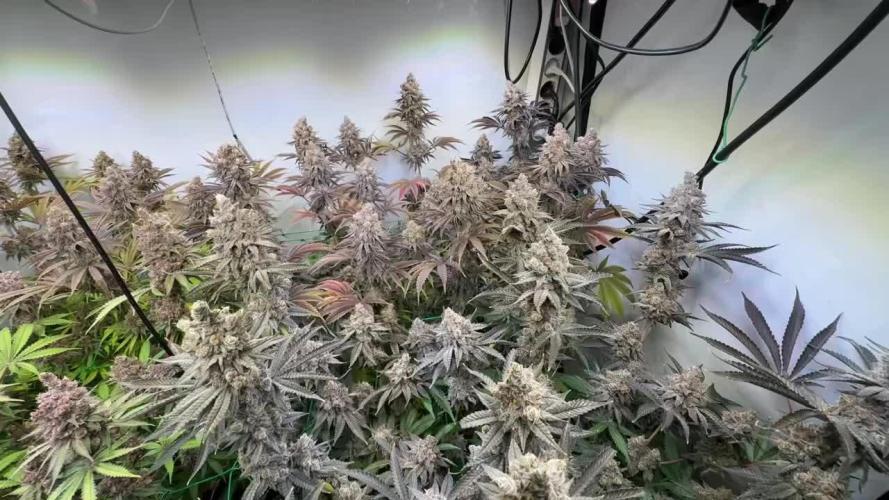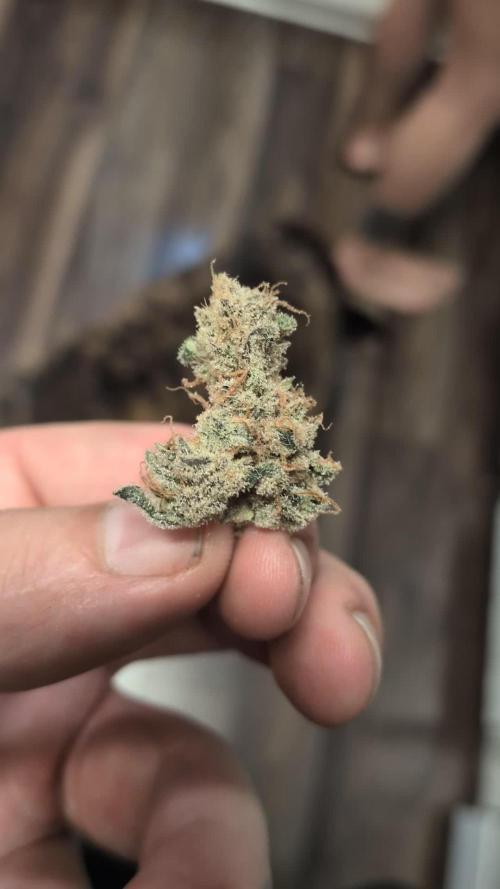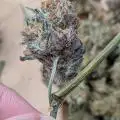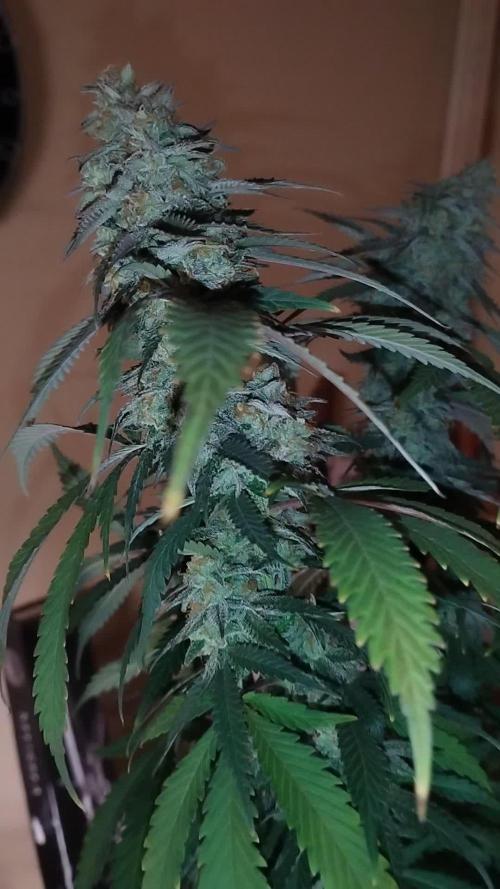The Grow Awards 2026 🏆 



































Likes
Comments
Share


@unknown23
Follow
See you next week with harvest And smoke report od Blueberry Bliss
Likes
10
Share


@XoticGROW666
Follow
Day 4 in flower. As yu can See this happy wifi gelato is bin repotted all organic grown compost tea & SST tea no bottles no nutes
Likes
16
Share


@Max1973
Follow
7 days exactly... 3 of the seeds made it.... all 3 look good....
just seed raising soil mixed with perlite, inside jiffy pots that break down in 2-6 weeks...
just normal tap water atm, and i'll water them less now, let them dry out abit...
Day 8 - pics/vid.... Had a look under the jiffy's, all 3 had 1-3 cm roots poking out, they went straight thru the jiffy like it was not even there..... (pic - Day 8 - Root straight thru all 3 pots.).... so, went into emergency repotting day... lol.......
i don't want the roots restricted or damaged in any way,
so, got what pots and soil i had, and put em in, (2 x 13.5 lt pot, and 1 x 7.7 lt).
Day 9 - some pics, bought a new tent (wait delivery), just got em under afew 6400k led's atm .... they seem happy..... 👍
😎
Likes
6
Share


@Hash_bear
Follow
Having a great time running this 3 gorilla punch from 42fastbuds genetic can’t wait to get to run some more stain that was a amazing opportunity thank everyone who is supporting me and my little brand
Likes
3
Share


@Mimbra
Follow
Parece que tienen una deficiencia de potasio ,hoy he regado con Monster bloom y floración de boom nutrients y Candy boom ,el problema ha sido que en la segunda semana se me pusieron las hojas amarillas y pensaba que era nitrógeno ,añadí nitrógeno y era potasio la cagué !! Ahora no se si es falta de potasio o la he torrado con nitrógeno y tengo que lavar raíces ,que opinais
Likes
155
Share


@Stony_German
Follow
Tag 63 Blüte
die 10. Woche beginnt und die Damen sind fast soweit aber für es sind immer noch zuviele Trichome klar und die ersten werden erst Bernsteinfarben. Würde ich WPFF also Waschen und Liverosin pressen wäre jetzt oder in paar Tagen Ernte. So wie es aussieht dauert es also noch ca 10 Tage. Meiner Erfahrung nach sind jetzt die entscheidenden Tage wo noch viele sekundäre Stoffe wie Terpene und Cannabinoide geildet werden. Der Duft ist Fantastisch bei jedem öffnen des Zeltes. Da der Sommer mit der Hitze eine Pause macht kann ich niedrigere Temp. halten und schone noch die ganzen flüchtigen Terpene. Also ich habe wirklich viel Glück mit dem Wetter gerade.
Diese letzte Tage habe ich angefangen nur noch mit Wasser zu gießen angepasst mit CalMag auf (EC 0,5)(PH 6,0-6,2). Nur der mineralisch gedüngte Frozen Tropicana Cherry mische ich noch 2ml/L Canna Flush ins Gießwasser um Salze rauszuspülen. Den Drain halte ich gering. Es reicht mir wenn 5% drain habe (der EC ist da bei 1,4 und PH 6,1). Besser könnte ich es mir nicht wünschen. Canna Terra hat wieder einmal mehr als perfekt funktioniert.
Die Ladies trinken auch noch viel auch das zeigt mir das Sie noch wollen und es noch zu früh wäre. Jeder grower kennt das ja am Ende trinken sie nur noch sehr langsam und sage dir ja das es soweit ist. Ich finde es sehr wichtig die Pflanzen zu beobachten und nicht irgendeinem Plan stur zu folgen.
Da wir in paar Tagen in Urlaub fahren muss ich wohl die Ernte und das aufhängen der Pflanze meinem alten Growbro anvertrauen genauso die vorzucht des neuen grows. Ich hoffe das die Damen noch nicht trocken sind wenn ich wieder da bin. Aber da will ich hier keinen zulabern. Ihr könnt euch ja vorstellen wie das ist jetzt gerade nicht da zu sein. Zum Glück kann ich mich da auf meinen Kumpel verlassen er hat auch schon viele Jahre Erfahrung.
Ich hoffe die Fotos gefallen euch.
Likes
8
Share


@Jays_Not_Here_Man
Follow
Love ❤️ my AC infinity tent! 2x4 is soooo easy to control. Just a simple humidifier, two small clip fans, and of course my AC infinity 4” fan and digital controller. All I have to do is fill the reservoir for the RH, and mist the seedlings 🌱 once per day. AC tech takes over and maintains the environment so easily. Using distilled water still, no nutes, nothing added. Just coasting and maintaining the environment for some healthy root development 🙂
Likes
5
Share


@RastaRick
Follow
Coming on well. Turing into monsters... I need a bigger light. Day 45 got second dose of bio pk 5-8. I have a bad feeling i will have to do 3 separate harvest days hahaha
Likes
18
Share


@blazin_skywalker
Follow
Growing some seeds I won from Diary of the Month here on Grow Diaries!!! I'm so grateful and excited for another learning experience doing what I love! Thank you, FastBuds! 🙏
Seed was germinated directly in Rapid Rooter placed in a seedling tray. I put her in darkness for 48 hours and then in a sunny window.
Three days later, the seedling's little head poked up and the next day she showed me her first true leaves - calling this day 1.
I kept the seedling tray in a sunny window and brought her outside for lunch on my sunny deck with me for the rest of the week.
Given the heatwave we were having here, I got her settled into her net basket sooner rather than later so that she could have a more stable environment.
This plant will is being grown indoors in an 2x4x8 Gorilla Grow Tent using an 8 gallon Current Culture Solo Bucket under California Lightworks 550 Solar System LED.
For grow media I am using clay pellets and I use the entire Cultured Solutions line of nutrients.
I will be showcasing this plant in a grow tutorial over on my YouTube channel and IGTV where I am going to show a detailed walk through of how I grew my original "Budzilla" plant. Unfortunately, I don't have a grow diary for her, but she is featured on my IG account.
The technique I use I created after harvesting my first grow. I had used low stress training on an autoflower and achieved beautiful results. I took notes the entire grow and conducted a postmortem.
I sincerely advise doing this for EVERY grow - especially when you are learning. It provides you opportunity to figure out what went right, what went wrong, what could have gone better, and what ideas you think you can toss into the mix to try to improve on the places that need revamping.
I did this and I came up with the hypothesis of starting my plant off-center in the net basket, and then growing it low and in a spiral around the outside. In my head, I thought something like this could really push the limits of low stress training, especially when used on an autoflower where we have a limited time of vegetative growth.
I didn't realize, at the time, JUST how effective the technique would be, but when the grower community on IG exploded over the sight of my plant, I started to get a feeling a did something right.
As I was still only growing my second plant in my entire grow career, I was completely oblivious to the fact that I had pushed the normal boundaries of an autoflower.... I had nothing else to really compare it to.
Nearly a year later, photos of my Budzilla are still being shared around social media in the grow community and I still get asked regularly about how I grew her.
And with that, we start here on the journey to attempt the recreation of my former masterpiece. But I'm taking it one step further and giving you a detailed, step-by-step guide so that even the newest of growers can follow along and learn how to push an autoflower to its beautiful edge. Plus.... It's really freaking cool to bonsai a plant 😎.
Anyway, please feel free to subscribe to my YouTube channel! The link is in my bio! I am updating as I go along!
Thanks for growing with me! ✌️💜🌱🙏
Likes
5
Share


@Capzinator
Follow
Last week happened a lot. I Was looking forward for day 49, because it marked the last foliation day. I put away the scrog net ä, because i think i just let those girl the freedom they need. The sidebranches got thicker, and I think i just let them go from now on. This is the first time im really giving nutritions, and the difference is huge. These nugs are crazy. They are 3 weeks before harvest much bigger than These from my first grow.
I also have some cal/mag issues on my strawberry Gorilla and my Red mimosa. Lets see if I can handle it.
Day 53: i think the plants are struggeling with the high variation in temperature. its between 10 degrees and 28. but i cant move them into a heated building. at least i hope that the yield will be ok, and next grow will be under other circumstances.
Likes
64
Share


@Grow4Releaf
Follow
She's almost done.
Starting to see cloudy so I'm just continuing to water. Started the water only last week so things should start to fade out alil more now. ..
Definitely learned alot for next time I run this strain.
Gonna be fun to redo.
See how this week goes tho, not the biggest plant but for the minimum amount of inputs she's done well.
But till the next update. Hope ur all doin well ,best of luck !!
Likes
13
Share


@Flowers_By_Irene
Follow
Started to dial down the nutrients, can already see a slight colour change in the leaves as they start to turn autumn colours with the reduced nitrogen
Did a flush/refresh of the roots using florakleen 0.5ml/Litre and left it in the reservoir for 2 days before dumping and adding fresh nutrients. The roots look bright white afterwards where they were nutrient stained a reddish brown before.
I swapped the side light from the left side to the right side to promote some more bud development on that side lower down
Happy with how the plants are looking but I had hoped that the buds would be a little fatter by this stage.
Clear winner so far is the bruce banner which has by far the biggest and most dense buds, then the gorilla glue next, then the blue dream although her buds are tall and skinny, then the gsc comes next with the critical last, most of the buds on the critical are still very small (it's the shortest plant and furthest away from the light)
Likes
21
Share


@CampaCavallo
Follow
Buongiorno amici canaposi💚
... A me sembra che la piccola Grape Ape si sia bloccata 😢
Processing
Likes
43
Share


@MUDBUG
Follow
11-24 Going smoothly starting to frost up LAMFER #1 and #3 is behind MELLO YELLO she took off fixed herself and is becoming a beautiful ass plant 33 inches so far and frosting up and getting fatter by the day im a week are so behind on the other 2 3 different phenos this round all are 100% different 1300 ppms total 6.0 ph a gallon a day between these 3 alone🔥🔥🔥🔥🍇🍇🍇🍇🍇🍇🍇🍇🍇🍇👌👌👌👌👌👌👌👌🏆🏆🏆🏆🏆⛽⛽⛽⛽⛽⛽⛽⛽
Likes
9
Share


@MG2009
Follow
01/19/2022
She was a he.
And he will be used for some pollination.
Not sure what both parents were, but growing nice, stem rubs stinky and definitely has fuzzy Melon smell.
Kinda reminds me of Tangie and model glue. Hopefully a good breeder will hit some choice branches on
Blue Matter F2 and test the offspring.
If interested Fuzzy Mellon is
Forbidden Fruit x Watermelon Zkittlez bred by Dying Breed Seeds & 3rd Gen Family.
Which is good genetics imo. But the wild card is who is th daddy?... Jerry springer show lol
According to leafly both parent are heavily on indica side so his stretch and node length points to a sativa daddy?
I never seen an indica with such large internodal spacing.
I know males will be stretching out more but still large compared to other males I've grown out.
So hope you follow along to see how his offspring will develop,
I will pollinate one branch of my favorite Blue Matter F2, and save some pollen for my Biscotti Skunk, Grape Skunk,and lemon og.
Likes
13
Share


@Cali_Grown_420
Follow
Probably going to start flushing her in about a week, she’s about ready to go!!! Smells like sweet strawberry candy it’s amazing!
I got her on a pK only diet currently for this last week, then a 3 day flush then chop!
Likes
Comments
Share


@Perfant94
Follow
It was a long grow, or at least it seemed like it, everything was looking so good so I was ready to harvest at week 9 but these bugs took a long time to mature.
Likes
9
Share


@AestheticGenetix
Follow
Plants are doing great. Will be harvesting at some point this week. Plant and pistils seem mature but the trichomes could use a little bit of time




















